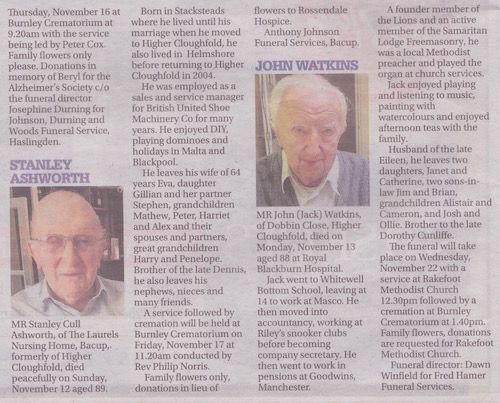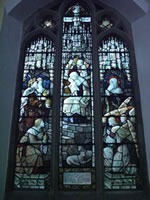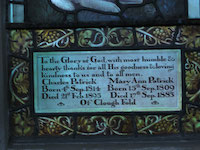2018 ambitions
The main success of 2017 was getting the website up and running again. I have no idea what happened there but it seems to be publishing ok now. It was surprising how much not being able to update this site impacted on my motivation for one place studies.
The second was my speaking as the Society of One Place Studies conference on the role of faith groups in general, and Rev JB Turner of Sion in particular, in conscientious objection in WW1. It was fascinating to get to grips with the reports of the tribunals, sermons and sundry prayer meetings in the Rossendale Free Press and pick out some of the themes which were involved.
An unanticipated highlight was having my article on John Myerscough, Victorian policeman, published in the FACHRS Newsletter. As well as detailing John's life and career in Rawtenstall, this looked at the extent to which local policemen were from outside the local area. The answer? Pretty much totally, in 1881 at any rate.
An unfulfilled objective was to complete Phase 1 of the FACHRS study into nonconformity in my place. This was in part due to family events and in part due to the need to complete the talk to the SOPS conference. I still intend to complete the work as the data is interesting, but it is probably too late for the FACHRS project.
Aims for 2018?
Now I have the documents from the National Archives about the Chancery case between Law and Royds which settled the dispute over Mary Ann Ashworth's will, one aim is to transcribe and upload these and work out what bits of local land were finally settled on each of her two nieces, Mary Alice and Elizabeth Ann.
Secondly I intend to try and 'Bridge the Gap' between the Bridge families known to be in the Chapel Hill area in the C17 and those in the same area in C19. Was it the same family in these farms for 200 years? This will involve my dipping my toe into some of the techniques used by one-name or surname researchers and this will help me work out whether a surname study is for me. If so, it will probably be my maternal grandmother's name of Draine as the other candidates (Watkins, Taylor and Hargreaves) are un-doable.
Thirdly I want to continue looking at the role of nonconformity in WW1 conscientious objection locally, possibly writing this up for the local history press somewhere.
I have decided to defer the Oxford Local History course until that parallel universe with plenty of time, probably the one which will hopefully start after I retire.
Here's to a happy and productive New Year!
Bridging the gap.
Although not strictly in Deadwenclough, some of these entries link the Bridge family with the enclave of Lower Booths around Chapel Hill, being tenants at various times of Chapel Hill farm, Meadowhead and other farms in the area. It is clear that the Bridge family were involved in land in the Deadwenclough area around Springhill.
I was interested therefore when transcribing the graves in Sion churchyard to find the grave of George Bridge, b 1824 Chapel Hill, d 1886 Cloughfold. It is possible, even probable, that this George Bridge is a descendent of the early Bridge residents in the area. The challenge was, can this be demonstrated?
Well that's a challenge for the New Year then!
RIP Gentlemen

Two former Springhill residents died on consecutive days and their obituaries are next to each other in the Rossendale Free Press (Nov 17, 2017).
Stanley Ashworth.
Mr Stanley Cull Ashworth of The Laurels Nursing Home, Bacup, formerly of Higher Cloughfold, died peacefully on Sunday November 12 aged 89.
Born in Stacksteads where he lived until his marriage when he moved to Higher Cloughfold, he also lived in Helmshore before returning to Higher Cloughfold in 2004.
He was employed as a sales and service manager for British United Shoe Machinery Co for many years. He enjoyed DIY, playing dominoes and holidays in Malta and Blackpool.
He leaves his wife of 64 years, Eva, daughter Gillian and her partner Stephen, grandchildren Matthew, Peter, Harriet and Alex and their spouses and partners, great grandchildren Harry and Penelope. Brother of the late Dennis, he also leaves his nephews, nieces and many friends.
John Watkins
Mr John (Jack) Watkins of Dobbin Close, Higher Cloughfold, died on Monday November 13 aged 88 at Royal Blackburn Hospital.
Jack went to Whitewell Bottom School, leaving at 14 to work in MASCO. He then moved into accountancy, working at Riley's snooker clubs before becoming company secretary. He then went to work in pensions in Godwins, Manchester.
A founder member of the Lions and an active member of Samaritan Lodge, Freemasonry, he was a Methodist local preacher and played the organ at church services.
Jack enjoyed playing and listening to music, painting with watercolours and enjoyed afternoon tea with the family.
Husband of the late Eileen, he leaves two daughters Janet and Catherine, two sons-in-law Jim and Brian, grandchildren Alastair, Cameron Josh and Ollie. Brother to the late Dorothy Cunliffe.
Stan lived in Springhill Lodge for 13 years and Jack in Sunset View for 22 years.
RIP, Gentlemen.
Check your sources
The' Buildings of England' guides by Nikolaus Pevsner are regarded as one of the ‘go to’ guides for buildings of architectural importance and can be both helpful and interesting. However they are secondary sources compiled with various degrees of local knowledge, and as such should be regarded with caution.
One example is seen in the “Lancashire North’ edition. Although no Springhill properties are listed in the guide, St Anne’s church, Edgeside, is included and was endowed by a Springhill resident, Captain Charles Patrick, being consecrated in 1885. Pevsner’s entry for St Anne’s reads:
'ST ANNE Ashworth Lane, Edgeside. By Thomas Bell of Burnely and Nelson, 1885. Low, aisleless and with a canted apse and plate-traceried windows. Base of a SW tower. W front with a big wheel window over a portal which embraces a pair of doors, like a Nonconformist church. Was this a deliberate ploy in an area of Methodist and Baptist supremacy. STAINED GLASS. Nave N. A good window by Shrigley and Hunt c 1895. The Adoration of the Magi and sheep. The church is groped with the substantial, slightly Gothic VICARAGE S. of 1910 and the long, low bare SCHOOL W. 1873 by Harry Thorndyke Perceval.'
The statement that the window was installed 'about 1895’ is true only in a very general sense. The window commemorates Charles Patrick and his wife, Mary Ann nee Ashworth. Charles Patrick died in 1895 and his date of death is included in the window.
A little probing reveals more however. Patrick’s will states that a stained glass window be installed in the church in memory of him and his wife as 'soon as conveniently maybe' after Rev Cross Jones ceasing to be vicar there. This suggests that relations between Patrick and Rev Cross Jones may not have been entirely cordial, or perhaps Cross Jones objected to stained glass in principle. This is an avenue for further study, although I’m not sure what documentation survives from St Annes’ from this period. The window was actually installed in 1903.






